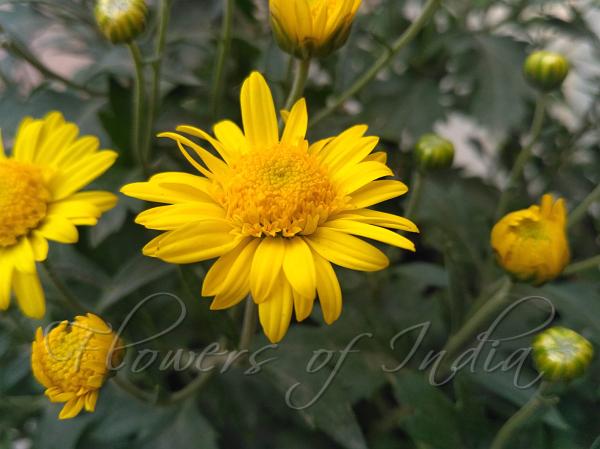|
| Indian Chrysanthemum |
|

|

| File size | 487318 |
| Original date | 11/15/18 12:41 PM |
| Resolution | 2048 x 1536 |
| Flash | Flash did not fire, auto |
| Focal length | 4.225mm |
| Exposure time | 1/595s |
| Aperture | 2.0 |
| Focus Distance | |
| Metering Mode | Center weighted average |
| Camera make | Xiaomi |
| Camera model | Redmi 3S |
| Sensor type | OneChipColorArea |
|
|
|
|
Photo: |
Botanical name: Chrysanthemum indicum Family: Asteraceae (Sunflower family)
Synonyms: Matricaria indica, Dendranthema indicum
Synonyms: Matricaria indica, Dendranthema indicum
Indian Chrysanthemum is a perennial herb, 25-80 cm
tall. It is one of the main parents of the florists' chrysanthemum in
horticulture. Flower-heads are many or few. Phyllaries in 5 rows,
scarious margin broad, white or brown. Ray floret are yellow, 1-1.3 cm,
tip entire or 3-finely toothed. Flower-heads are borne in a lax
flat-topped cyme at branch-ends. Stems are erect or spreading,
branched, sparsely hairy. Lower leaves wither at anthesis. Middle stem
leaves are carried on stalks 1-2 cm; leaf blade ovate or elliptic-ovate
in outline, 3-7 x 2-4 cm, both surfaces pale green or olive, sparsely
velvet-hairy, pinnately cut or lobed, base flat, somewhat heart-shaped
or broadly wedge-shaped. Seed-pods are 1.5-1.8 mm. Flowering:
June-November.
Medicinal uses: The plant is used in China to
treat eye ailments. In conjunction with black pepper it is used in the
treatment of gonorrhoea. The leaves are depurative. They are used in
China in the treatment of migraine. The flowers are used in the
treatment of furuncle, scrofula, deep-rooted boils, inflammation of the
throat, eyes and cervix, eczema, itchiness of the skin and
hypertension. They have a rejuvenating effect when used over a long
period of time.
The plant is used in China to
treat eye ailments. In conjunction with black pepper it is used in the
treatment of gonorrhoea. The leaves are depurative. They are used in
China in the treatment of migraine. The flowers are used in the
treatment of furuncle, scrofula, deep-rooted boils, inflammation of the
throat, eyes and cervix, eczema, itchiness of the skin and
hypertension. They have a rejuvenating effect when used over a long
period of time.
Medicinal uses:
 The plant is used in China to
treat eye ailments. In conjunction with black pepper it is used in the
treatment of gonorrhoea. The leaves are depurative. They are used in
China in the treatment of migraine. The flowers are used in the
treatment of furuncle, scrofula, deep-rooted boils, inflammation of the
throat, eyes and cervix, eczema, itchiness of the skin and
hypertension. They have a rejuvenating effect when used over a long
period of time.
The plant is used in China to
treat eye ailments. In conjunction with black pepper it is used in the
treatment of gonorrhoea. The leaves are depurative. They are used in
China in the treatment of migraine. The flowers are used in the
treatment of furuncle, scrofula, deep-rooted boils, inflammation of the
throat, eyes and cervix, eczema, itchiness of the skin and
hypertension. They have a rejuvenating effect when used over a long
period of time. | Identification credit: Tabish | Photographed in Delhi. |
• Is this flower misidentified? If yes,